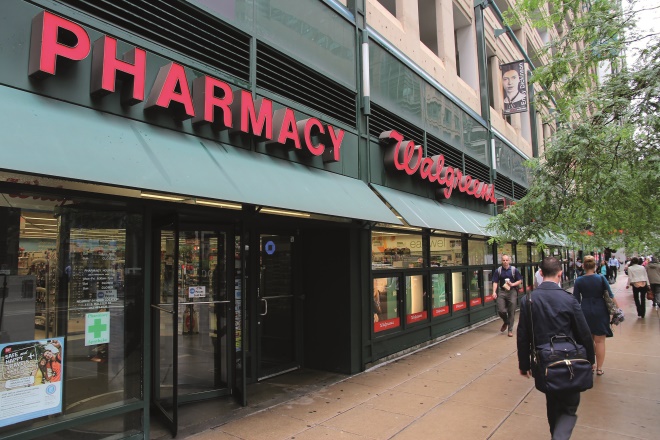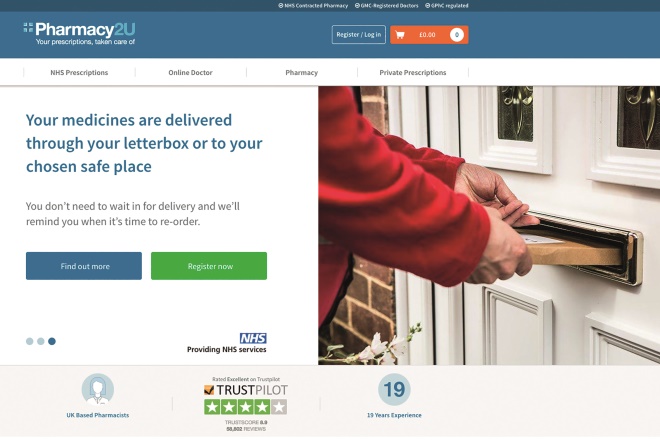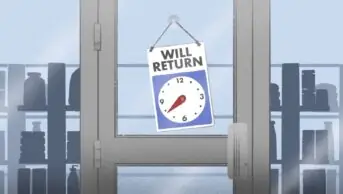
Valero Doval / Ikon Images
Type in your medication and your doctor’s name. Then have your treatments posted direct to your home or workplace. It is an attractive offering for a busy person, but the sustainability of online pharmacy is far from certain.
Pharmacy multiples are investing heavily in online services in an effort to compete with online companies such as Pharmacy2U and other potential new competitors, including Amazon. These multiples hope their trusted brand and the ability to use their high street presence to offer more than a simple online dispensing service will give them a competitive advantage.
If you look at any other retail type activity, everybody is developing an online presence because a lot of people are choosing to shop online
The government says that healthcare consumers are increasingly demanding more accessible and convenient online services that have become the norm in retail and banking. But is pharmacy a special case?
“We like to think that pharmacy is different as a health profession, and I would actually strongly subscribe to that view,” says Sandra Gidley, chair of the English Pharmacy Board at the Royal Pharmaceutical Society, “but the reality is if you look at any other retail type activity, everybody is developing an online presence because a lot of people are choosing to shop online.”
Figures from the Office of National Statistics (ONS) for April 2018 show that 17.3% of all retailing in Great Britain now takes place online, up from around 10% five years ago[1],[2]
. Toys R Us and Maplin are the latest in a long line of well-known high street retailers forced to go into administration because of struggling sales, and much of the blame is being directed at rising competition from online retailers. Meanwhile, Marks & Spencer will close more than 100 stores across the UK by 2022 as part of its plan to move a third of its sales online.
Getting estimates of the current value of the online prescription market is difficult, but the consensus is that it is tiny. According to NHS Digital, there are 335 distance-selling pharmacies in England, of which Pharmacy2U is the biggest.
People’s expectations are rising about the customer experience they expect and those expectations are being set not by other pharmacies but by other retailers, such as Amazon and Netflix
Pharmacy2U only dispenses a quarter of a million prescription items per month, says Gareth Jones, head of corporate affairs at the National Pharmacy Association, which is “a very tiny proportion of the entire prescription market”. He explains: “That would add up to 3 million items per year out of [a total of] 1 billion.” The company posted a £20m financial loss for 2016–2017, but declined to comment on its future development plans[3]
.
Dan Sheldon, head of digital at Well Pharmacy, says his best estimate is that “online pharmacy accounts for half a percent of the total prescription market today”, but he believes there is “huge growth potential”.

Source: Courtesy of Dan Sheldon
Dan Sheldon, head of digital at Well Pharmacy, says that online pharmacy has “huge growth potential”
“People’s expectations are rising about the customer experience they expect,” says Sheldon, “and those expectations are being set not by other pharmacies but by other retailers, such as Amazon and Netflix.”
Internet-only players have seen massive market growth over the past five years. According to the ONS, 8.6% of all retail business is conducted by retailers without stores — those such as online and mail order companies, market stalls and door-to-door sellers — and 79% of this business was conducted online in April 2018, compared with around 60% five years ago[1],[2]
.
The multiples
A spokesperson for Boots UK emphasises that the way its customers and patients want to manage their prescriptions and access pharmacy services online is “evolving”.
“Through our online pharmacy service, patients can manage their repeat prescriptions,” he says. “Through our online clinics, we also offer a range of pharmacy services, including for erectile dysfunction, acne, hair loss, period delay, stopping smoking and malaria prevention.”
For LloydsPharmacy, growing its online services is a strategic priority. “Through lloydspharmacy.com patients can sign up to receive free delivery of their repeat prescriptions, or can take advantage of our click and collect service for non-prescription items,” says Andy Sloman, interim digital director at parent company Celesio UK and managing director of LloydsPharmacy Online Doctor.

Source: Courtesy of Andy Sloman
Andy Sloman, interim digital director at LloydsPharmacy’s parent company Celesio UK and managing director of LloydsPharmacy Online Doctor, says that the physical and digital worlds of healthcare can complement each other to provide more customer choice
The LloydsPharmacy Online Doctor service was one of the first online healthcare organisations to register with the Care Quality Commission (CQC) and more than 1.4 million patients have registered with the service since 2002. “Our expert team can prescribe medication to be collected directly from one of our LloydsPharmacy stores,” he says.
Sloman explains that the company has plans to introduce new services that make it easier for patients to keep track of their health online. “We also believe that technology can be used to help people better manage their long-term conditions, so that is an area where we are interested in developing new services.”
Our vision is that customers will have choice about when and where they get their prescriptions
Ultimately, says Sloman, LloydsPharmacy believes that the physical and digital worlds of healthcare can complement each other to provide more customer choice. “For example, a patient who uses our online doctor service may require contraception. One of our doctors can prescribe this online for the patient to pick up in a pharmacy. When they go to collect their medication from the pharmacy, the pharmacist will carry out checks, such as measuring their BMI, to make sure it is safe to dispense.”
Well Pharmacy has recently developed an app as part of its new online prescription service, which is being rolled out in England. It will allow customers to order both repeat and one-off prescriptions, and builds on Well’s existing online prescription service and hub-and-spoke dispensing model.
“Our vision is that customers will have choice about when and where they get their prescriptions,” says Sheldon. “Some will want to use an app, some will want to come into the store, some might want to engage with us in other ways as well, so we are building a platform that will enable us to do all of that.”
Picking up medicines in a pharmacy is not going to work for everyone and neither is having it delivered to their home, says Sheldon, so Well is looking at both of these options and considering others. “People use Amazon lockers now, so we are looking at things like that, too.”
How big will it get?
In the United States, big pharmacy retailers such as Walgreens and CVS have been focused on the “online space” for a while, and online pharmacy is becoming much more normalised, Sheldon says.

Source: Shutterstock.com
Big pharmacy retailers in the United States, such as Walgreens and CVS, have been focused on the “online space” for a while
Rumours during 2017 that Amazon was about to enter the drug distribution market, initially in the United States, have not yet come to fruition and some press reports by Reuters suggest these plans have been put on hold, at least in the short term[4]
. A spokesperson for Amazon refused to confirm this, saying: “Amazon does not comment on rumours or speculation.”
Providers who employ only pharmacist prescribers can exploit this gap in the regulations, meaning that the systems and processes used are not under the remit of any regulator
There are a few factors holding back online pharmacy in the UK, says Sheldon, in particular a lack of consumer trust. Online pharmacies, which are regulated by the General Pharmaceutical Council (GPhC), are often linked to online prescribing services, which have been plagued by questions over the quality of care they provide. In 2017, the CQC found that 86% of online primary care providers were not providing “safe” care, which led to two services closing – Doctor Matt and MD Direct. At that time, the prescribing arm of Pharmacy2U was also found not to be providing safe care in accordance with the regulations, but it was rated as safe by the CQC in another inspection in December 2017[5],[6]
. By February 2018, the CQC reported that the number of providers who were found not to be providing safe care had decreased to 43%.

Source: Courtesy of Pharmacy2u
The prescribing arm of Pharmacy2U was found not to be providing safe care in a 2017 inspection, but it was rated as safe by the CQC later the same year
There is also a loophole in the regulations, according to Mohammed Hussain, a pharmacist and senior clinical lead at NHS Digital, who explains that online prescribing services only have to register with the CQC if they employ a listed healthcare professional, which does not include pharmacists.
“Providers who employ only pharmacist prescribers can exploit this gap in the regulations,” says Hussain, “meaning that the systems and processes used are not under the remit of any regulator although the individuals themselves are regulated by the General Pharmaceutical Council”.
He emphasises that getting a prescription online should not be compared with ordering groceries from Tesco.
“Quite rightly, there is an expectation of regulation to ensure that patient safety is built in,” he adds.
While few would disagree that the demand for online pharmacy services is likely to grow, the consensus is that the proportion of online sales is unlikely to reach the level of the retail sector.
Gidley believes that pharmacy customers choose to shop online less frequently because having their prescription dispensed is often reactive: “You’ve been to the surgery, you might as well just pop in and get that prescription.” On the other hand, for someone who is stable on one medicine a month, “I can see that it would be very attractive for them to think I might as well get it posted to my place of work, it makes life easier for me”, she says.

Source: MAG / The Pharmaceutical Journal
Sandra Gidley, chair of the English Pharmacy Board at the Royal Pharmaceutical Society, believes that ordering medicines online can distance patients from their local pharmacy
Community pharmacy has to acknowledge the online trend, she adds, and “almost step up what it offers on a personal level because those kind of clinical services are going to become more and more important in keeping the customer patient base”.
Face-to-face versus online
Jones predicts that a large proportion of patients will want to continue to access pharmacies in the traditional way. The community pharmacist network offers a convenient service for customers, he points out. “It is often much easier to walk into the pharmacy near the office on your way into work than it is to deal with a parcel that may have ended up back in the sorting office.”
There is evidence that people value a face-to-face service when it comes to healthcare, he adds[7]
. “And it’s not just that people want it, it quite often makes a significant difference to their health” and has benefits for the wider health system, he says. When a pharmacist sees a patient regularly they are more likely to notice if their chronic condition is deteriorating and a review is needed. “The pharmacist spots it because they see them week in week out,” says Jones.
Not only does online pharmacy miss out on that face-to-face contact but there is also the huge expense of delivery. “The idea that it’s more efficient is not yet proven,” Jones emphasises. “It’s an expensive model.”
LloydsPharmacy has recently begun charging patients for home deliveries unless their medicines are ordered online, in which case they are dispensed via the company’s hub.

Source: Courtesy of Gareth Jones
Gareth Jones, head of corporate affairs at the National Pharmacy Association, predicts that a large proportion of patients will want to continue to access pharmacies in the traditional way
Gidley believes that ordering medicines online can distance patients from their local pharmacy and will have an impact on LloydsPharmacy and what it can provide. “Obviously they’ve built up a relationship for years with some of the customers, they know their little foibles, and the customer is being told ‘we won’t be able to deal with you after a certain time, you’ve got to go through this anonymous central online system’.”
If large numbers of the public start using a centralised online supply there would be an impact on the network and inevitably local pharmacies would close
Jones warns that more use of centralised dispensing could lead to closures on the high street: “If large numbers of the public start using a centralised online supply there would be an impact on the network and inevitably local pharmacies would close.”
However, Hussain argues that some multiples have developed effective hub-and-spoke models, which are freeing pharmacists’ time for patient care. For example, up to 60% of prescriptions at some Well pharmacies are now sent to its hub and the medicines shipped back to the store for patients to pick up, he says.
What about smaller pharmacies?
“I don’t think there is much doubt that all pharmacies need an internet presence,” says Martin Bennett, chair and superintendent pharmacist at Associated Chemists (Wicker) Ltd, an independent pharmacy in Sheffield. “But I don’t believe it’s necessary to aim at providing a service for the whole country. We need to use the internet to enhance and improve the local services that we already provide.”
The sort of online presence a community pharmacy should offer will depend on their customer base and what customers are looking for, says Jones.
Smaller pharmacies might need to list opening times online and link to the local GP surgeries so repeat prescriptions can be requested easily, but much more than that can be expensive to do properly, says Gidley, and there is a risk of looking amateurish.
At the moment I would say that most small pharmacies do not have the spare cash to take a punt on this
“At the moment I would say that most small pharmacies do not have the spare cash to take a punt on this,” she says.
Despite a move towards people expecting everything more quickly and easily, there are still a lot of customers who do not want their prescriptions dispensed via the internet, Gidley adds: “If you are a small pharmacy with an established customer base, my personal view is, for the investment, I’m not convinced the return would be justified.”
How one independent pharmacy set up its website
JWW Allison & Sons, an independent community pharmacy in Cockermouth, Cumbria, initially set up its own website.
“We felt that we needed an online presence,” explains pharmacist and director Nat Mitchell. “I get frustrated when I want to see what a business offers and they have nothing online to showcase this. Restaurants with no menu, for example, are missing out massively.”
“I am surprised at how many pharmacies don’t even have something as simple as a landing page,” he adds.

Source: Courtesy of Nat Mitchell
Nat Mitchell, pharmacist and director of JWW Allison & Sons, sees the pharmacy’s website as “a window into our business” so it lists all the services it provides
Mitchell used a simple WordPress site because it was both free and easy to update, but it became apparent that some customers wanted the ability to order prescriptions online so he contacted a pharmacy website provider to enable this.
However, this function became obsolete when the local GP surgery banned third-party repeat prescription ordering so the pharmacy reverted back to its WordPress site, not only to save money but also because it was easier to add or remove information as needed.
Although websites set up by dedicated companies can look nicer, work better and have increased functionality, says Mitchell, there is a cost involved, as well as a danger that the sites look a little generic and will be a hassle to update. “Our [previous] site had pharmacist spelled incorrectly and it took an age to correct,” he says.
Mitchell sees the pharmacy’s website as “a window into our business” so it lists all the services it provides. “There is a temptation to only include the most interesting information, but for a pharmacy I feel that there has to be an element of completeness as you never know what a patient is looking for,” says Mitchell.
“Given time and resource I’d like to have a more interactive and attractive website that works across all platforms, but for now I’m happy with what it does. It is linked to our Facebook site, which helps to spread our message and aids interaction with our patients.”
The website is also promoted to patients on the pharmacy’s leaflets, its van, through a monthly column in a local magazine, and via Twitter and NHS Choices.
Resource: General Pharmaceutical Council. Guidance for registered pharmacies providing pharmacy services at a distance, including on the internet. April 2015.
Future of repeat prescription apps
There are companies offering targeted online services for independent pharmacies. For example, Buckinghamshire-based The Pharmacy Centre provides websites and apps, including repeat prescription ordering and e-commerce for some clients. Other innovative services are being developed that could assist smaller pharmacy chains and independents to provide online services for their customers.
Apps that enable patients in England to order repeat prescriptions and have them sent to their homes or to a local pharmacy already exist.
Some of these apps, such as ECHO, require the patient to type in the drugs and doses that they require. The order is sent to ECHO’s pharmacy partner, which sends an efax to the patient’s GP surgery to request the prescription. Once the pharmacy receives the prescription, the medicine is posted to the patient.
Several clinical commissioning groups have banned pharmacies from ordering prescriptions on behalf of patients in a bid to reduce medicines waste, and some have included use of the ECHO app in this ban. ECHO is using third-party ordering, explains Mohammed Hussain, a pharmacist and senior clinical lead at NHS Digital, and the reasoning was that if bricks and mortar premises were not allowed to make requests, they should not be accepted from a third-party online provider.
Other apps have got around this by linking to GP software systems so the patient’s repeat prescription request is sent to the GP practice. Patients using these apps can access a list of the drugs they have been prescribed and select the ones they need. Several such apps are linked to specific GP system software, including Patient Access aligned to EMIS, and another — DIMEC — has been designed to work with a multitude of GP systems.

Source: Courtesy of Chris Turner
Chris Turner is chief operating officer at DIMEC, a repeat prescription ordering app that includes an Amazon-style click and collect feature
DIMEC, which was set up by two pharmacists, also includes an Amazon-style click and collect feature. Chris Turner, chief operating officer at DIMEC, says that, as a pharmacist, he understands that ordering the prescription is only half the battle. “Patients need to know when and where it’s ready for collection,” he says, so DIMEC sends patients notifications throughout the whole process: ‘it’s with the GP’, or ‘it’s being dispensed’ or ‘it’s ready for collection’ to keep patients informed and save wasted trips to the pharmacy. DIMEC also offers a repeat dispensing service to pharmacies, which automates the administration-heavy service many pharmacies offer.
Hussain predicts that models that integrate with the GP computer systems will become more prevalent and will “allow pharmacies to scale up as a national network” to offer a convenient online service to patients. “Such models give patients everything that they could get from online pharmacy but still the benefit of the local pharmacy, the ability to walk in off the street and get immediate healthcare advice,” adds Gareth Jones, head of corporate affairs at the National Pharmacy Association.
References
[1] Office for National Statistics. Statistical Bulletin: Retail sales, Great Britain: April 2018. Available at https://www.ons.gov.uk/businessindustryandtrade/retailindustry/bulletins/retailsales/april2018 (accessed June 2018)
[2] Office for National Statistics. Dataset: Retail Sales Index internet sales. Available at https://www.ons.gov.uk/businessindustryandtrade/retailindustry/datasets/retailsalesindexinternetsales (accessed June 2018)
[3] Companies House. Group of companies’ accounts made up to 31 March 2017. Available at https://beta.companieshouse.gov.uk/company/03802593/filing-history (accessed June 2018).
[4] Reuters. Drug suppliers’ shares rise as looming Amazon threat appears to ease. 16 April 2018. Available at: https://in.reuters.com/article/amazon-com-healthcare/drug-suppliers-shares-rise-as-looming-amazon-threat-appears-to-ease-idINKBN1HN2GQ (accessed June 2018)
[5] Care Quality Commission. Pharmacy2U Ltd inspection report. 29 June 2017. Available at: http://www.cqc.org.uk/sites/default/files/new_reports/AAAG3954.pdf (accessed June 2018).
[6] Care Quality Commission. Pharmacy2U Ltd inspection report. 16 February 2018. Available at: http://www.cqc.org.uk/sites/default/files/new_reports/AAAH0178.pdf (accessed June 2018).
[7] National Pharmacy Association. Face-to-face. Available at: https://www.npa.co.uk/representing-you/campaigns/face-face-report/ (accessed June 2018)


